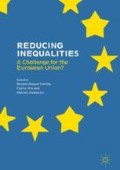Abstract
The theoretical advances on the subject of inequality have been both significant and varied, opening up renewed forms of understanding and explanation. The most important theories on and analyses of contemporary social inequalities adopt a multidimensional perspective. In this chapter, we will start by comparing Greece, Spain and Portugal to other European Union countries with regard to income inequality. Then in a more subjective dimension, we will compare individuals’ perception of their economic satisfaction and well-being. Finally, we will present an overview of the main labour market indicators to better understand the changes that have occurred in terms of employment, unemployment and precarious work in these Southern countries.
Notes
- 1.
The first indicator, S80/S20, is a ‘percentile ratio’ calculated as the ratio of total income received by the 20% of the population with the highest income to that received by 20% with the lowest income level. The second indicator used is the Gini coefficient , a summary measure that ranges from 0 (complete equality) to 100 (complete inequality).
- 2.
Comparing 2010 and 2014, we see that Romania (+2.2 points since 2010), Estonia and Bulgaria (both with a rise of 1.2 points) stand out as the EU countries with the greatest rise in inequality between the 20% highest and 20% lowest incomes of the population (S80/S20). When we look at the evolution of the Gini, Hungary saw the greatest rise in inequality: from 24.1% to 28.2% (+4.1 percentage points). The European average (28 countries) also rose from 30.5% to 31% between 2010 and 2014 (+0.5 p.p.).
- 3.
According to Eurostat , the indicator ‘households’ ability to make ends meet’ is based on the self-reported difficulty of making ends meet and provides a measurement of poverty in terms of the household’s experienced feeling of poverty (Eurostat, LFS).
- 4.
This indicator measures the self-reported overall satisfaction with the financial situation of the household and is measured on a scale of 0–10, where 0 corresponds to the lowest and 10 to the highest grade of satisfaction (Eurostat, LFS).
References
Atkinson, A. (2015). Inequality: What can be done? Cambridge, MA: Harvard University Press.
Atkinson, A. B., Marlier, E., Montaigne, F., & Reinstadler, A. (2010). Income poverty and income inequality. In A. Atkinson & E. Marlier (Eds.), Living conditions in Europe and the Europe 2020 agenda (pp. 101–130). Luxembourg: Eurostat Statistical Books. ISBN 978-92-79-16351-7.
Bartolini, L., Gropas, R., & Triandafyllidou, A. (2015). Escaping the crisis and emancipating oneself: Highly skilled mobility from Southern Europe. Altreitalie: Forum Europe and Migrations in the Third Millennium, 51, 36–52.
Bourdieu, P. (1979). La Distinction. Critique sociale du jugement. Paris: Minuit.
Carmo, R. M., & Cantante, F. (2015). Desigualdades, redistribuição e o impacto do desemprego: tendências recentes e efeitos da crise económico-financeir. Sociologia Problemas e Práticas, 77, 33–51.
Costa, A. F. (2012). Desigualdades Sociais Contemporâneas. Lisbon: Editora Mundos Sociais.
Gialis, S., & Leontidou, L. (2016). Antinomies of flexibilization and atypical employment in Mediterranean Europe: Greek, Italian and Spanish regions during the crisis. European Urban and Regional Studies, 23(4), 716–733.
Human Development Report. (2014). Sustaining human progress reducing vulnerabilities and building resilience. New York: United Nations Development Programme.
IMF. (2014). Fiscal policy and income inequality. IMF Policy Paper. Retrieved from https://www.imf.org/external/np/speeches/2014/031314.htm
OECD. (2015). In it together: Why less inequality benefits all. Paris: OECD Publications.
Piketty, T. (2014). Capital in the twenty first century. Cambridge, MA: Belknap Press.
Therborn, G. (Ed.). (2006). Inequalities of the world. New theoretical frameworks, multiple empirical approaches. London: Verso.
Therborn, G. (2013). The killing fields of inequality. London: Polity.
Wilkinson, R., & Pickett, K. (2009). The spirit level: Why more equal societies almost always do better. London: Allen Lane/Penguin Books.
Author information
Authors and Affiliations
Editor information
Editors and Affiliations
Rights and permissions
Copyright information
© 2018 The Author(s)
About this chapter
Cite this chapter
Carmo, R.M., Matias, A.R. (2018). Unemployment, Precariousness and Poverty as Drivers of Social Inequality: The Case of the Southern European Countries. In: Carmo, R., Rio, C., Medgyesi, M. (eds) Reducing Inequalities. Palgrave Macmillan, Cham. https://doi.org/10.1007/978-3-319-65006-7_4
Download citation
DOI: https://doi.org/10.1007/978-3-319-65006-7_4
Published:
Publisher Name: Palgrave Macmillan, Cham
Print ISBN: 978-3-319-65005-0
Online ISBN: 978-3-319-65006-7
eBook Packages: Social SciencesSocial Sciences (R0)

